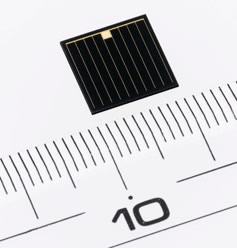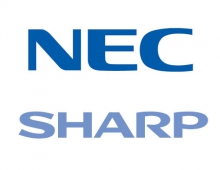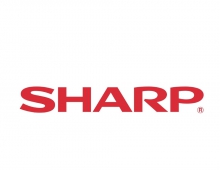
Sharp Develops Solar Cell with Highest Conversion Efficiency
Sharp has achieved the world's highest solar cell conversion efficiency of 37.9% using a triple-junction compound solar cell in which three photo-absorption layers are stacked together.
 Sharp's breakthrough is a result of a research and development initiative promoted by Japan's New Energy and Industrial Technology Development Organization (NEDO) on the theme of "R&D on Innovative Solar Cells." Measurement of the value of 37.9% was confirmed at the National Institute of Advanced Industrial Science and Technology (AIST).
Sharp's breakthrough is a result of a research and development initiative promoted by Japan's New Energy and Industrial Technology Development Organization (NEDO) on the theme of "R&D on Innovative Solar Cells." Measurement of the value of 37.9% was confirmed at the National Institute of Advanced Industrial Science and Technology (AIST).
Compound solar cells utilize photo-absorption layers made from compounds consisting of two or more elements, such as indium and gallium. The basic structure of this latest triple-junction compound solar cell uses proprietary Sharp technology that enables efficient stacking of the three photo-absorption layers, with InGaAs (indium gallium arsenide) as the bottom layer.
By optimizing the relative proportions of indium, gallium, and arsenide, Sharp increased the efficiency with which the cell absorbs sunlight at its various wavelengths. This improvement enabled Sharp to achieve the world's highest solar cell conversion efficiency of 37.9%.
Sharp's aim for the future is to apply this latest development to concentrator photovoltaic power systems that use lenses to collect and convert sunlight into electricity. The company also foresees numerous other practical applications for the cells, such as on space satellites and vehicles.
 Sharp's breakthrough is a result of a research and development initiative promoted by Japan's New Energy and Industrial Technology Development Organization (NEDO) on the theme of "R&D on Innovative Solar Cells." Measurement of the value of 37.9% was confirmed at the National Institute of Advanced Industrial Science and Technology (AIST).
Sharp's breakthrough is a result of a research and development initiative promoted by Japan's New Energy and Industrial Technology Development Organization (NEDO) on the theme of "R&D on Innovative Solar Cells." Measurement of the value of 37.9% was confirmed at the National Institute of Advanced Industrial Science and Technology (AIST).
Compound solar cells utilize photo-absorption layers made from compounds consisting of two or more elements, such as indium and gallium. The basic structure of this latest triple-junction compound solar cell uses proprietary Sharp technology that enables efficient stacking of the three photo-absorption layers, with InGaAs (indium gallium arsenide) as the bottom layer.
By optimizing the relative proportions of indium, gallium, and arsenide, Sharp increased the efficiency with which the cell absorbs sunlight at its various wavelengths. This improvement enabled Sharp to achieve the world's highest solar cell conversion efficiency of 37.9%.
Sharp's aim for the future is to apply this latest development to concentrator photovoltaic power systems that use lenses to collect and convert sunlight into electricity. The company also foresees numerous other practical applications for the cells, such as on space satellites and vehicles.





















